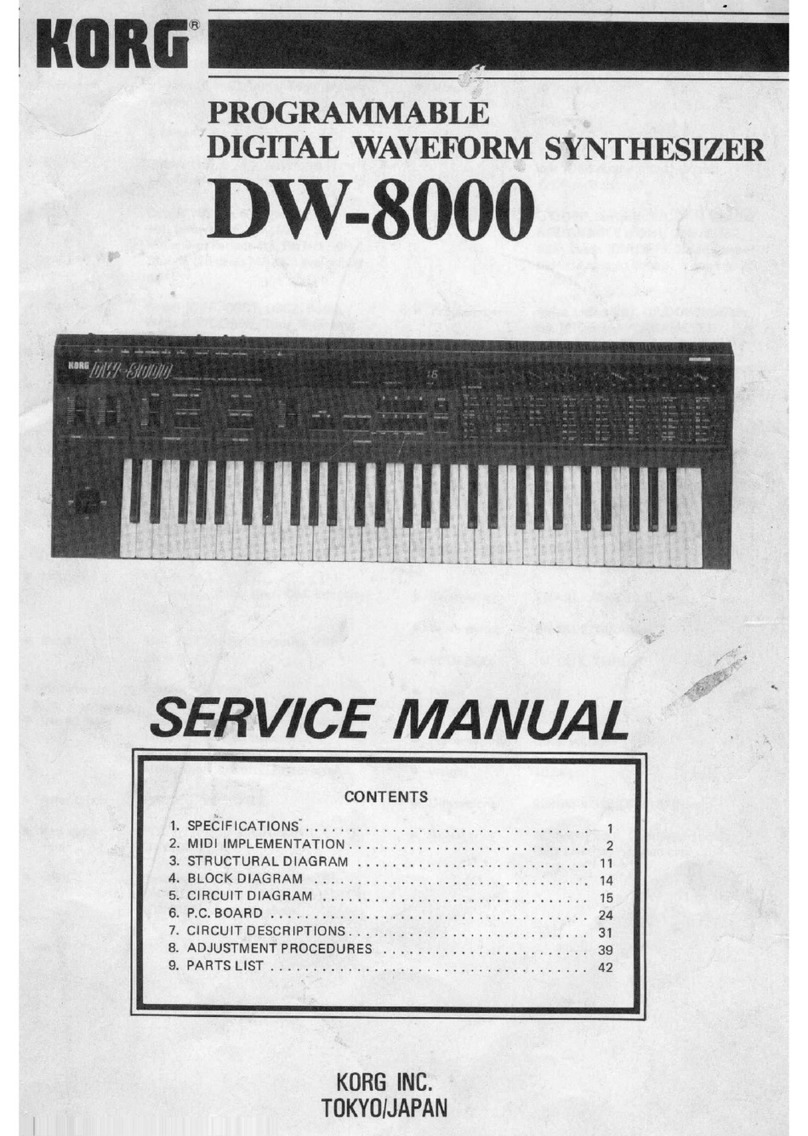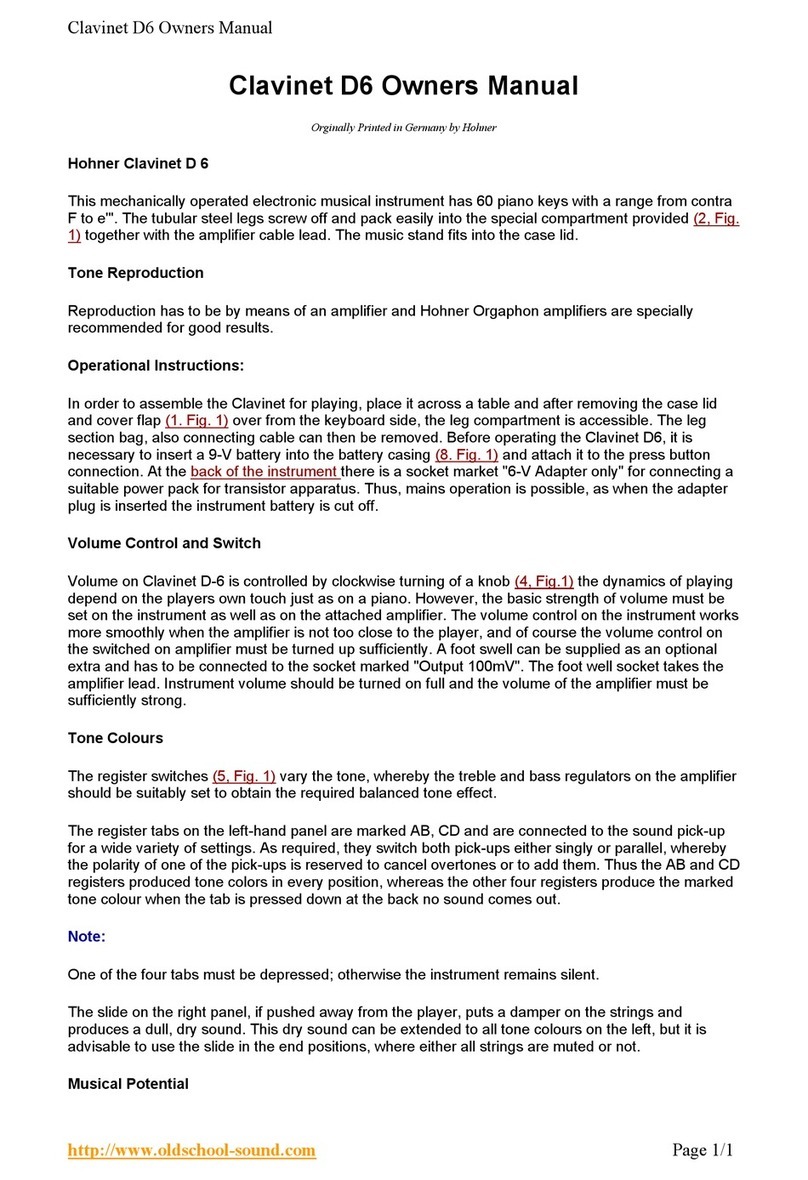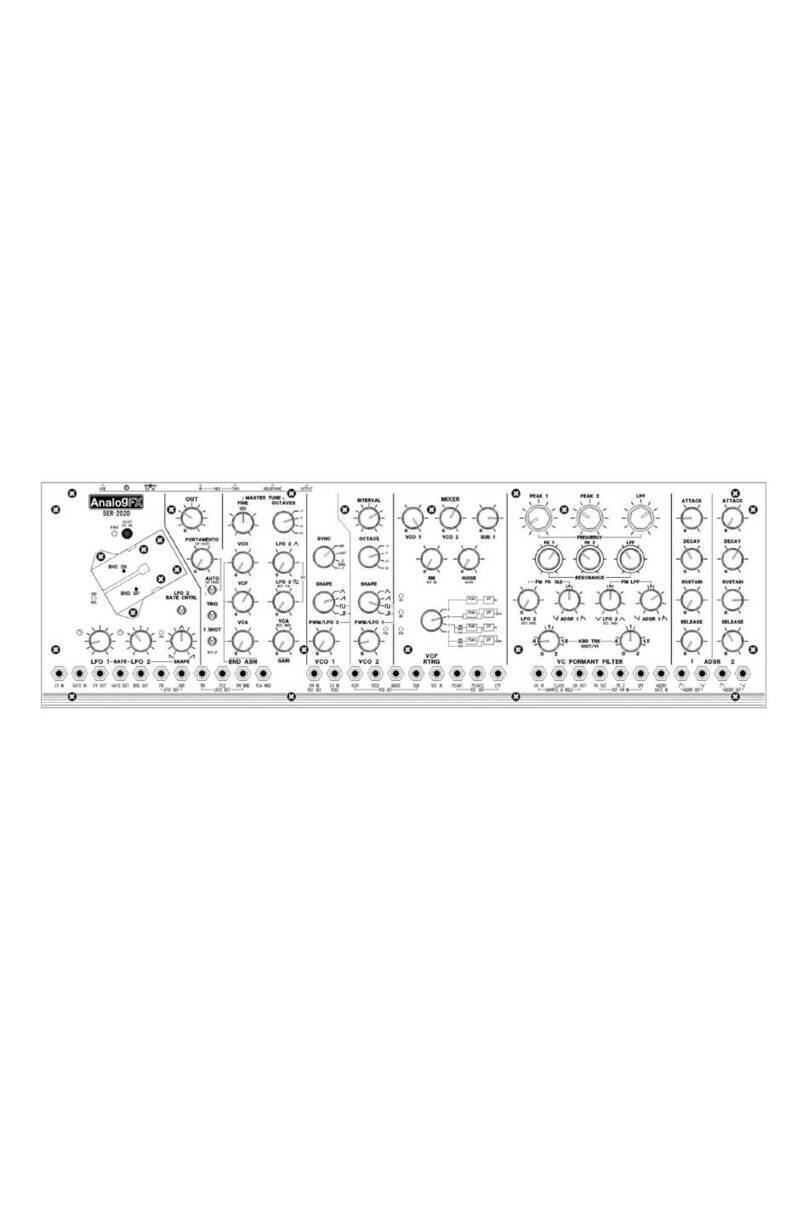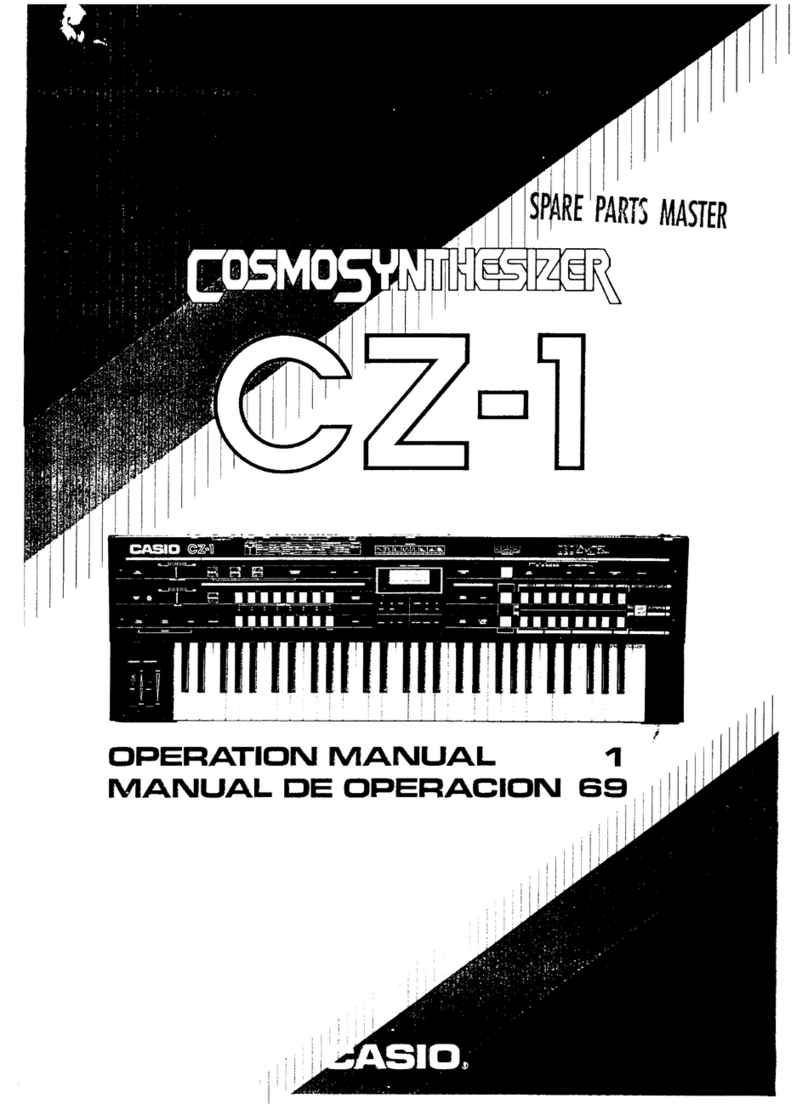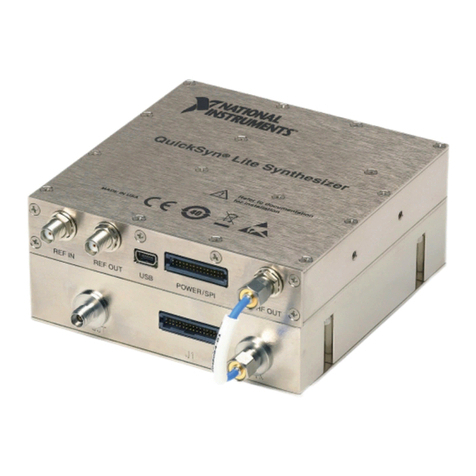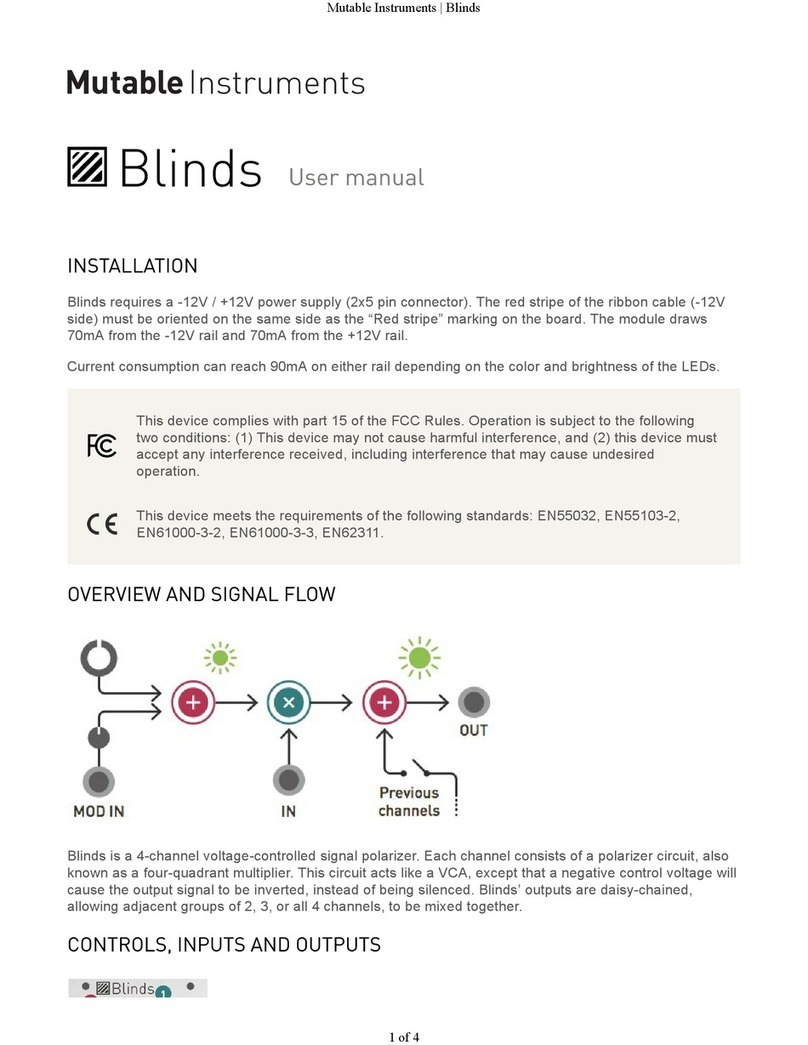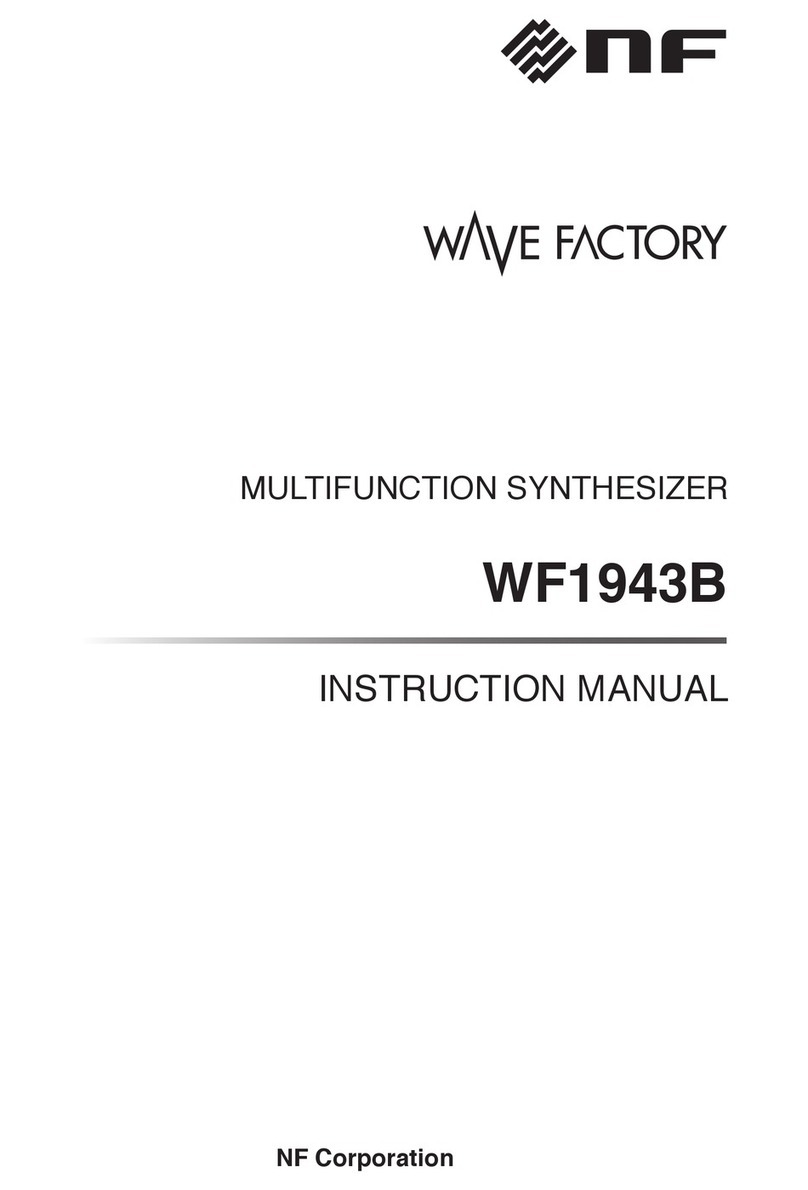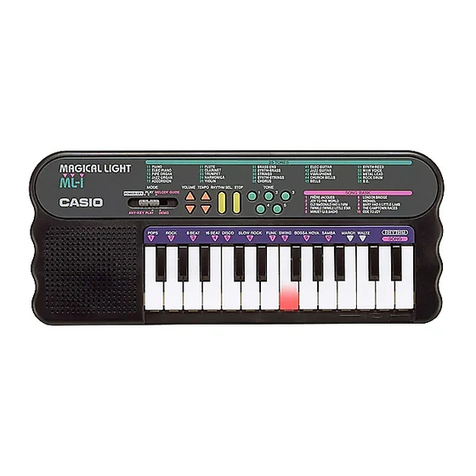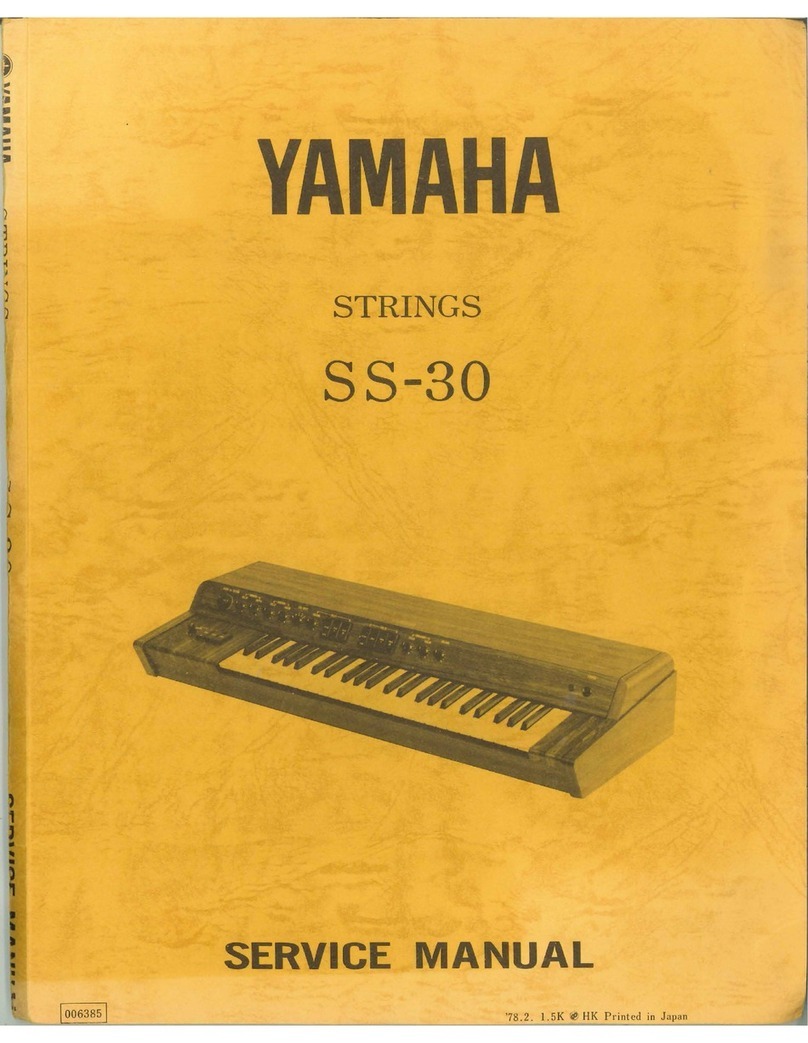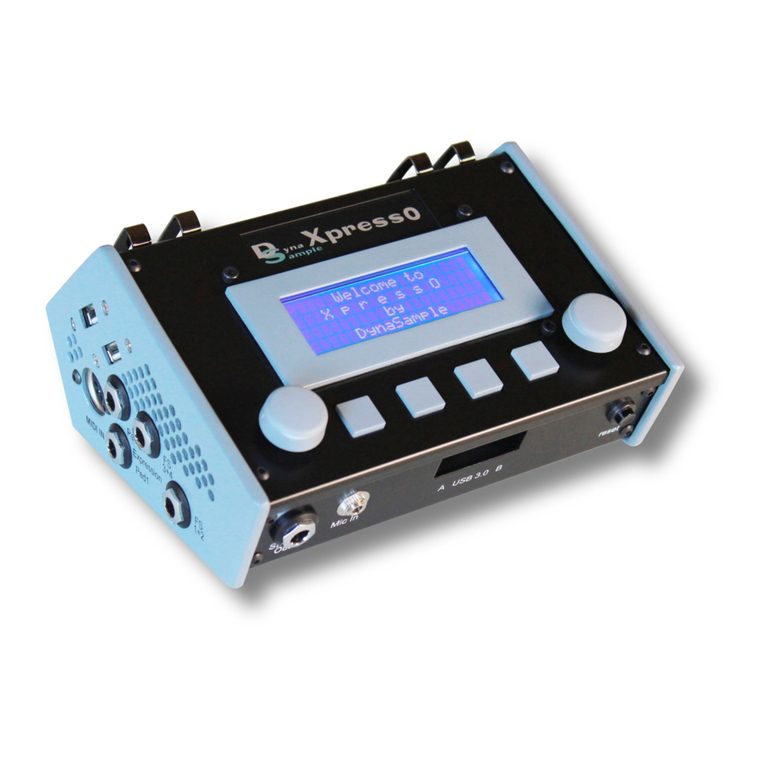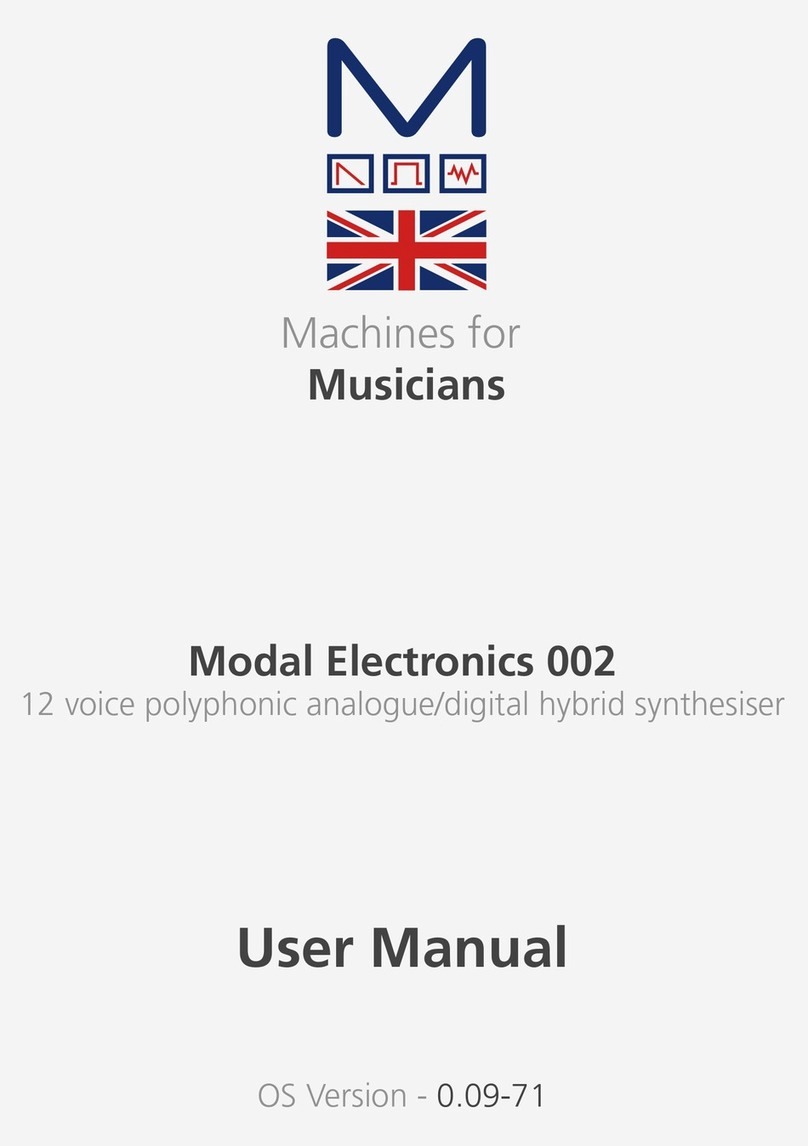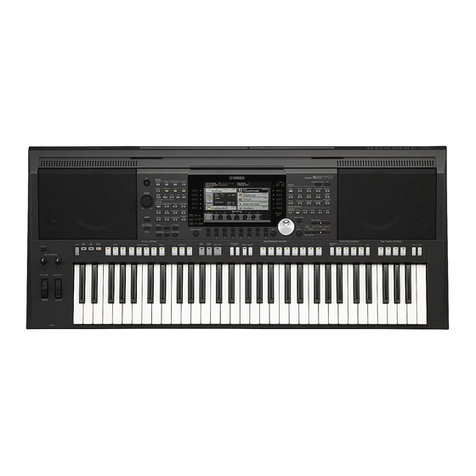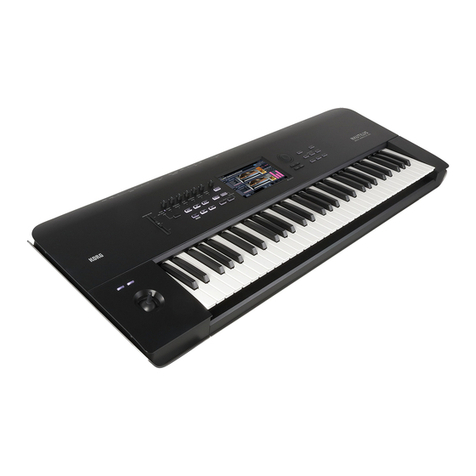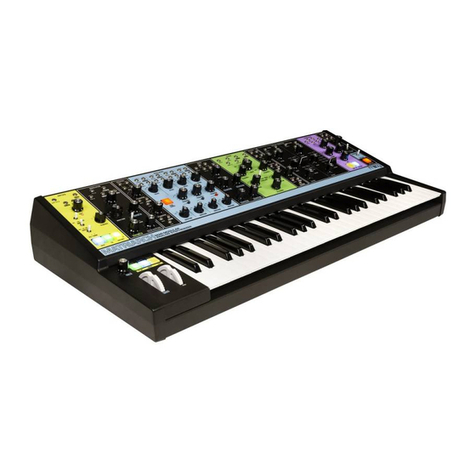ELECTRONIC MUSIC LABORATORIES ElectroComp EML - 200 User manual

ElectroComp EML
-
200
Manual
elect
rmic
music
ISOO~CTGOTIGS,
inc
P.0.
Box
H,
Vernon,
Connecticut
06066iTel:
1203)
875.0751

LEARNING
THROUGH
PARTICIPATION
The
Electrocomp
Users
Manual
PREFACE
The purpose of this manual
is
to develop the skills necessary for
the use of the ElectroComp in the generation of electronic music.
"Learning Through Partici~ation'~develops the skills required
for using the ElectroComp by: 1. presenting a rudimentary
description of the characteristics of musical tones,
2.
presenting
a
brief description of the ElectroComp and its individual modules,
and
3.
presenting
a
series of experiments designed to engage the
user in discovery through use.

CHARACTERISTICS OF MUSICAL TONES
Sound
is
the sensation resulting from the detection of changes in
air pressure by the ear and
is
characterized by:
1.
frequency,
or pitch,
2.
amplitude, or volume,
3.
duration,
4.
attack and
decay, and
5.
timbre, or overtone content.
The FREQUENCY, or pitch of a musical
sound
is
the rate of re-
petition of the fundamental. The fundamental
is
the lowest tone
present in the sound and is recognized as the pitch due to
its
large amplitude in comparison to any overtones that may be pre-
sent.
The AMPLITUDE, or volume of a sound
is
its relative loudness.
The DURATION of a sound
is
the length of time that it persists.
The ATTACK of a sound refers to the time required for the sound
to reach its maximum amplitude.
The DECAY of a sound refers to the time required for a tone to
decrease to
its
minimum amplitude.
TIMBRE refers to the frequency content of a sound and
is
expressed
in terms of the fundamental and overtones. The fundamental is the
lowest tone present and
is
recognized, normally, as the pitch of the
sound due to its normally large amplitude in comparison to the ampli-
tude of the overtones. The overtones, technically called harmonics,
are whole number frequency multiples of the fundamental; generally
of reduced amplitude with respect to the fundamental.
There are three other easily recognizable characteristics achievable
in
sound:
1. frequency modulation, or vibrato,
2.
amplitude modu-
lation, or tremolo, and
3.
frequency shifting, or ring modulation.
FREQUENCY MODULATION, or vibrato
is
a variation in pitch of
a musical sound. Traditionally frequency modulation occurs at
about seven cycles per second. Electronically,
it
can occur
at
any frequency, and
if
done very rapidly, about
200
cycles per
second, sounds very similar to ring modulation.
In
frequency
modulation, the overtones maintain their whole number frequency
relationship with the fundamental.
AMPLITUDE MODULATION, or tremolo
is
a variation in the loud-
ness or volume of a sound.

CHARACTERISTICS OF MUSICAL, TONES
FREQUENCY SHIFTING, or ring modulation
is
a variation
in
pitch
where each frequency component, fundamental and overtones,
is
shifted by the same amount. The harmonics or overtones do not
maintain their whole number relationship with the fundamental,
thereby affecting a change in timbre.
Frequency shifting
is
accomplished Uy combining two tones in
a device called a ring modulator. The tone to be shifted
is
called
the carrier, the tone doing the shifting is called the modulator.
The resultant of this combination
is
the sum and difference frequencies
of the two tones.

THE ELECTROCOMP
Visual inspection of the ElectroComp reveals that the system
is
divided into two sections, upper and lower, and that each of these
sections
is
further divided by the use of outlining into individual
modules. Examination of an individual module reveals three
primary constituants
:
1. jacks for accepting inputs and distributing
outputs,
2.
control knobs for managing module function, and
3.
lettering and guidelines indicating function and organization.
Jack arrangement on the front panel always assumes one of two
configurations. The single jack indicates an input. The double
jack indicates an output with the same signal available at both
jacks for distribution to more than one input.
Control knobs manage system function in any of the following fashions
depending upon the module being discussed: 1. control the gain, or
volume, of a signal,
2.
control the frequency of a signal,
3.
control
the duration of a signal, or
4.
control the function of
a
module.
Lettering and guidelines indicate function and organization. The lettering
can be divided into the three catagories of: 1. module name,
2.
control
knob function, and
3.
jacknumbering. The guidelines present on each
module indicate the flow of signals from input to output.
Master Oscillator
The Master Oscillator generates sine, square and triangle waveforms
simultaneously over the range of
.
012 to 18,000 cycles per second.
There are two controls that operate in a multiplicative fashion to select
the output frequency. The range control selects one of six decade
ranges, while the frequency control selects the desired frequency within
that range
The distinguishing characteristics of the three waveforms are their
overtone content and instantaneous amplitudes.
There are six output jacks available, two for each waveform.
White Noise Generator
The White Noise Generator produces a pitchless sound due to the
random combination of all frequencies; much like the sound of
rushing air.
There are two output jacks available.

THE ELECTROCOMP
Voltage Controlled Oscillators
The Voltage Controlled Oscillators provide
a
sawtooth waveform
in
the audio range where the output frequency follows
a
changing input
signal.
There are two controls, center frequency and swing. The center
frequency control determines the output frequency of the voltage
controlled oscillator (VCO). If there
is
no input present, the VCO
maintains the frequency set by the center frequency control. If
there
is
an input present, the output frequency increases and de-
creases with the changing input signal. The amount
of
change
is
dictated by the swing control. The frequency of the input signal
determines the rate of change of the output.
There
is
one input jack for the control voltage input and two jacks
for the sawtooth output.
Reverberator
The reverberator provides the capability of modifying the timbre
of an input frequency
by
use of a spring type mechanical delay.
There are two controls available, gain and depth. The gain con-
trol determines the volume of the output, while the depth control
determines the proportion of reverberated to unreverberated signal
appearing at the output.
There are
one
input and two output jacks.
Electronic Switch
The Electronic Switch provides the capability of alternating two
signals,
A
and
B,
to a single output. The duration of each signal
at the output
is
independently adjustable over
a
300
to
1
range by
means of
A
and
B
channel duration controls. As well as the dur-
ation controls, each input has an associated gain control.
There are two input jacks, one for each channel, and two output
jacks.
High Pass Filter
The High Pass Filter modifies the timbre of an input frequency by
passing through to the putput
all
frequencies above the cutoff ire-
quency and attenuating all frequencies below the cutoff frequency.
The cutoff frequency
is
adjustable with the cut frequency control.
One input and two output jacks are provided.

THE ELECTROCOMP
Low
Pass
Filter
The Low
Pass
Filter modifies the timbre of an input frequency by
passing through to the output all frequencies below the cut fre-
quency and attenuating
all
frequencies above the cut frequency.
The cutoff frequency
is
adjustable with the cut frequency control.
One input and two output jacks are provided.
Band Pass and Band Reject Filters.
If the two filters are connected
in
series a Band Pass Filter will
be formed where those frequencies between the high and low cut
frequencies will be passed through to the output. The connection
of the two filters in parallel will form a Xand Reject Filter where
those frequencies above the High Pass Filter's cut frequency and
those frequencies below the Low Pass Filter's cut frequency will
pass to the output.
Waveshaper
The Waveshaper consists of three modules in one,
a
Sampler, an
Envelope Generator and a Modulator. Due to the complexity, these
three devices will be described separately.
The Sampler
The Sampler
is
a device which inspects a continuously varying input,
such
as
a triangle wave, and converts it into an incrementally varying
function, such
as
an ascending and descending staircase. This output
functions as a Voltage Controlled Oscillator input. There are two
controls associated with this device which together control the sampling
interval of the staircase.
There
is
one input and two output jacks.
The Envelope Generator
The Envelope Generator provides the capability of generating a wave-
form with controlled attack and decay. This waveform can be generated
synchronously from the sampling rate of the sampler or from a manual
pushbutton. Either of these modes are selectable by means of the Mod-
ulators's Mode Select switch. The attack and decay are controllable in
duration by means of two controls labelled attack and decay.

THE ELECTROCOMP
Envelope Generator
The Envelope Generator output, available at two jacks,
is
useful
in conjunction with the modulators for amplitude modulation. It
may also be used a VCO input.
The Modulator
The Modulator can operate
in
four separate modes
as
determined by
the Mode Select switch. The first of these modes
is
Amplitude Modu-
lation where the Modulator will accept a modulating frequency, such
as a low frequency sine wave, and a carrier, such as white noise,
and shape it in intensity or volume. The second mode
of
operation
is
Ring Modulation where the sum and difference frequencies of the
carrier and modulator are produced
at
t.he output. The third and fourth
modes of operation are also forms of Amplitude Modulation, however,
the output of the Envelope Generator
is
used to shape the carrier fre-
quency
in
amplitude. When in this mode, the connection from the en-
velope generator output to the modulator input
is
made automatically.
The Modulator contains two input jacks, carrier and modulator, and
two output jacks.
Dual Mixers
The Dual Mixers provide for the summing of three input signals per
channel with each input having its own gain control.
As
well, any
portion of the output of either mixer can be routed to the other
channel by means of
a
pan control.
There
is
one input jack available for each input. There are six output
jacks, two for each channel and two wired for stereo headphone use.
(Note: Headphones of
200
ohm impedance may be used at any system
'
output to monitor.
)
Ring Modulator
The Ring Modulator provides the capability of accepting two input,
arrier and modulator, and profucing the sum and difference frequencies
at the output. As well, the Ring Modulator will accept the output of
the Envelope Generator at its modulation input, allowing Amplitude
Modulation.
The Ring Modulator contains two input jacks, modulator and carrier,
and two output jacks.

THE ELECTROCOMP
Microphone Amplifier
The Microphone Amplifier is a low distortion amplifier designed
to bring low level signals up to the standard level used in the
ElectroComp. An input gain, volume, control
is
provided.
There is one input jack
and
two output
jacks.

EXPERIMENTS
This nection consists of a group of experiments designed to develop
an understanding of the capabilities of the ElectroComp. Each ex-
periment will consist of three parts
-
purpose, procedure and result.
The following general comments should be understood before be-
ginning the experiments:
1. There are no combinations of connections within the ElectroComp
that
can
possibly do any harm to the user or equipment.
2.
The system should never be disassembled or modified without
permission from the factory.
3;
Generally, when a function fails to function as expected it will be
'found that one of the following conditions exsist:
a. gain, or volume, turned off.
b. frequency of sound source not in hearing range.
c. no output connection made.
4.
The output device for the experiments can be either an amplifier
and associated speakers, as shown below, or stereo headphones of
200
ohms or greater.
ELECTROCOMP AMPLIFIER SPEAKERS

EXPERIMENTS
1. Character of White Noise.
Purpose
-
to note the characteristic pitchless sound of White Noise.
Procedure
-
a. connect jack
1.
White Noise Generator output, to
jack
26,
a left Mixer input.
b. adjust the gain control of Mixer input
26
to a com-
fortable hearing level.
c. rotate the left pan control.
Result
-
note the pitchless sound of white noise and the fact that
its presence does not produce the weariness of a con-
stant tone. Note that varying the gain control of the
Mixer
is
the simplest form of amplitude modulation and
if done with proper motion, can simulate ocean waves.
Note that rotating the pan control moves the output from
the left to right speakers.
2. Harmonic content
Of
the Master Oscillator
!s
waveforms.
Purpose
-
Procedure
-
Result
to note the relative volume of the sine, triangle and
square waves
at
400, 8,000, and 12 cycles per second.
a. set the frequency of the Master Oscillator at 400
cycles per second (range control at 100 and frequency
control at
4).
b.
connect jack 2, sine wave output, to jack
26,
Mixer
input,
-
listen.
c. move jack
2,
sine wave output, to jack
3,
triangle
wave output,
-
listen.
d.
move jack
3,
triangle wave output, to jack 4, square
wave output,
-
listen.
e. repeat the above sequence with the frequency set at
8000 and 12 cycles per second.
note that at 400 cycles the relative volume of the harmonic-
less sine tone
is
less than both the triangle and square.
However, at 8,000 cycles they sound identical in volume
due to the fact that the first harmonic,
24,000
cycles, of
both the square and triangle
is
beyond our hearing range.
At the other end of the hearing range, 12 cycles or less,
we can no longer detect the pure sine tone; but can still
detect the triangle and square due to the higher harmonics
present in each of these waveforms.

EXPERIMENTS
3.
VCO Center Frequaency Control.
Purpose
-
to develop an understanding of the use of the center
frequency control.
Procedure
-
a. turn the center frequency control full counterclock-
wise (CCW).
b. connect jack
6,
VCO output, to jack
26,
left Mixer
input.
c. slowly rotate the center frequency control clock-
wise (CW).
Result
-
note the apparant increase in pitch with CW rotation
and the difference in timbre of the sawtooth as compared
to the sine, triangle and square waves.
4.
VCO Swing Control.
Purpose
-
to develop an understanding of the use
of
the swing
control.
Procedure
-
a.
set the frequency of the Master Oscillator at
.
2
cycles per second (range switch at
.
I
and
frequency
control at
2).
b. set
swing
control full CCW and center frequency at
12:oo.
c. connect jack
6,
VCO output, to jack 26, Mixer input
d.
connect jack
5,
VCO input, to jack
2,
sine output.
e. slowly rotate swing control CW.
Result
-
note that as the swing control
is
rotated CW, the amount
of frequency change above and below the center frequency
increases. By using the triangle and square waves in
place of the sine wave, it will become apparant that the
VCO follows the shape of the input signal with corres-
ponding changes in pitch.
5.
7CO Rate Control
Purpose
-
to determine the affect of rate changes of the input
signal on the VCO's output.

EXPERIMENTS
5.
VCO
Rate Control.
ocedure
-
a.
maintain the setup of the previous experiment.
b. set the swing control at
9
:00.
c. vary the frequency control of the Master Oscillator.
Result
-
note that the rate of oscillation of the control input
determines the rate of change of the VCO. If the
range switch of the Master Oscillator
is
set at 100,
it will be noted that the VCO1s output will appear to
have changed in timbre due to rapid frequency mod-
ulation.
6.
Reverberator Delay.
Purpose
-
to observe the delaying affects of the Reverberator.
Procedure
-
a. turn the gain and depth controls full
CW.
b. connect jack
8,
VCO output, to jack
9,
Reverb
input.
c. connect jack
10,
Reverb output, to jack
26,
Mixer input.
d. move jack
9,
Reverb input,
in
and out.
Result
-
note that
the
sound persists after the removal of jack
9,
Reverb input, indicating that the input signal
is
delayed
in
its
passage through the reverb.
7.
Reverb Depth Control.
Purpose
-
to determine the affect of depth control on Reverb
output.
Procedure
-
a. maintain the setup of the previous experiment.
b. connect jack
2,
sine output, to jack
7,
VCO input.
c. set the Master Oscillator to 1 cycle per second.
d. rotate. the depth control CCW.
Result
-
note that rotation of the depth control
CCW.
mixes the
reverberated and unreverberated sawtooth of the VCO.

EXPERIMENTS
8.
Electronic Switching.
Purpose
-
to determine the capability of the Electronic Switch to
alternate two tones to a single output and the method
for controlling their duration at this output.
Procedure
-
a.
set the output frequency of the Master Oscillator
and the
fir
st VCO
In
the audio range.
b.
turn the duration controls,
A
on time and
B
on time,
full
C
W.
c. connect jack 2, sine output, to jack 11, awitch input.
d.
connect jack
6,
VCO output, to jack 14, switch input.
e. connect jack 12, switch output, to jack 26, Mixer
input.
f.
slowly rotate each duration control
CCW.
g. remove connection between jack 6,
VCO
output,
and jack
14,
Switch input.
h. rotate duration controls.
Result
-
note that it
is
possible to control the rate and duration of
alternation of two tones to a single output or one tone and
silence. Interesting affects can be achieved
by
rotating
the frequency controls of the sound sources while the
switch
is
alternating tones
.
9.
Square Wave Filtering
-
High Pass.
Purpose
-
to modify the harmonic content of a square wave
by
use
of
the High
Pass
Filter.
Procedure
-
a. set the frequency of the Master Oscillator at
400
cycles.
b.
connect jack
4,
square wave ouput, to jack 15, High
Pass Filter input.
c. connect jack
16,
High Pass output, to jack 26, Mixer
input.
d. rotate the cut frequency control
CCW.
Result
-
note the change
in
volume and timbre of the tone due to
the attenuation of the fundamental and lower harmonics.

EXPERIMENTS
10. Square Wave Filtering
-
Low Pass Filter.
Purpose
-
to modify the harmonic content of the square wave by
use of the Low
Pass
Filter.
Procedure
-
a. set the frequency of the Master Oscillator at 400
cycles per second.
h,
connect jack-4, square wave output, to jack 17,
Low Pass Filter input.
c. connect jack 18, Low Pass Filter output, to jack
26, Mixer input.
d. rotate the cut frequency control CW.
Result
-
note the change
in
volume and timbre due to the attenuation
of the higher harmonics and that full CW rotation changes
the square wave into a sine wave.
11. Scale Generation.
Purpose
-
to develop an understanding of the Sampler when used
as
a
control voltage for the VCO's.
Procedure
-
a.
turn the rate and duration controls of the Sampler
full C
W.
b.
turn the swing control of the VCO to 12:OO.
c.
set the frequency of the Master Oscillator to .2
cycles per second.
d.
connect jack
3,
triangle wave output, to jack 19,
Sampler input.
e. connect jack 21, Sampler output, to jack
5,
VCO
,
input.
f.
connect jack
6,
VCO output, to jack 26, Mixer input.
g. vary rate and duration of the Sampler.
Result
-
note the staircase of tones generated by the VCO output
due to the conversion of the triangle wave from a contin-
uously varying function to an incrementally varying func-
tion. Note that the time interval between notes is deter-
mined by the rate and duration controls.

12. VCO Control using the Envelope Generator.
Purpose
-
to use the Envelope Generator to control the VCOts
output frequency.
Procedure
-
a. turn attack and decay controls full CW.
b. turn center frequency control full CCW.
c. turn duration and rate controls to 12:OO.
d. select manual mode.
e. connect jack 22, envelope output, to jack 5, VCO
input
.
f.
connect jack 6, VCO output, to jack 26, Mixer
input.
g.
depress Manual Button in and out.
h. slowly rotate decay CCW.
3..
push button.
j.
rotate attack CCW.
k. push button.
1. select automatic mode.
m. vary attack and decay.
n. vary rate and duration.
Result
-
note that the
VCO
follows the shape of the Envelope
Generators output in frequency. Also note that the
rate of envelope generation can
be
controlled auto-
matically or manually.
13.
Amplitude Modulation using the Envelope Generator
.
Purpose
-
to use the Envelope Generator to amplitude modulate
White Noise.
Procedure
-
a.
turn the duration and rate controls of the sampler
to 12:oo.
b.
select manual mode.
c. turn attack and decay controls CW.
d. connect jack 1, White Noise output, to jack 25,
carrier input.
e. connect jack 24, Modulator output, to jack 26,
Mixer input.
f. push manual button
in
and out
at
a slow rate.
g. add attack and decay
-
push button.
h. select automatic mode.
i.
vary attack and decay.

EXPERIMENTS
1
3.
Amplitude Modulation using the Envelope Generator
.
Result
-
note that
in
the manual mode and with the attack and
decay full
CW,
depressing the pushbutton merely
passes the carrier signal to the output. However, by
adding attack and decay, it
is
possible to shape the
volume of the tone. Selecting the automatic modes
allows the shaping to occur at a rate set by the rate
and duration controls. This should be repeated with
the sawtooth and sine waves as carrier inputs.
14. Ring Modulation.
Purpose
-
to use the Modulator
as
a Ring Modulator.
Procedure
-
a.
select the Ring mode.
b.
set the frequency of the
VCO
to 10:OO.
c.
set the frequency of the Master Oscillator to
120
cycles per second.
d. connect jack 2, sine output, to jack 23, modulation
input.
e. connect jack 6, VCO output, to jack 25, carrier
input.
f.
connect jack 24, modulator output, to jack 26,
Mixer input.
g. rotate the Master Oscillator over
its
decade range.
Result
-
note that as the Master Oscillator
is
rotated
CW,
the
output of the Modulator appears to have two separate
tones, one increasing with
CW
rotation and the other
decreasing with
CW
rotation. These are the sum and
difference frequencies.
15. Amplitude Modulation using the Master Oscillator.
Purpose
-
to amplitude modulate the sawtooth with the sine wave.
Procedure
-
a. select the Amplitude mode.
.b.
connect jack 6, VCO output, to jack 25, carrier
input.
c. connect jakc 2, sine output, to jack 23, modulation
input.
d. connect jack 24, modulator output, to jack 26, Mixer
input.
e. vary the frequency
of
the Master Oscillator
in
the
.
1
range. 16.

EXPERIMENTS
15.
Amplitude Modulation using the Master Oscillator.
Results
-
note that the Modulator produces
an
envelope of the
VCO
output. This experiment may be repeated
using the triangle and square wave outputs. This
experiment also should be repeated
in
the Ring mode.
16.
Ring Modulation of external sounds.
Purpose
-
to Ring Modulate external sounds using the Microphone
Amplifier.
Procedure
-
a. connect
a
mike to jack 35, Microphone input.
b.
connect jack
36,
Microphone output, to
jack
32,
Ring Modulator modulating input.
c. (connect jack
33,
modulator output to jack
26,
Mixer input.
d.
connect jack
2,
sine output, to jack
34,
carrier
input.
e. set the frequency of
the
Master Oscillator at 100
cycles.
f.
speak into the microphone.
Result
-
note the change in timbre and frequency content of the
external sound.
Following this set of experiments are additional outlined experiments.

Random
rythrnn
and tone generation.
,
f/tctro
TAuoTTv
ILL£
C~iy
coNN.
,
---
AVAILABLE THROUGH
ELECTRONIC
MUSIC
LAB.
INC.
PO
BOX
1334,
HARTFORD.
CONN.
-MASTER
OSCILLATOR
-
-
SWITCH
-
-?>
/-Â
CENTER FREQ-
4
c*.
-0:
,'
A
ON
TIME
6
A
GAIN
1
2.0
-
1000
FREQ.
HZ.
\
I/
-0-
/-Â
OEPl
H
0
GAIN
HIGH
WSS-
f
FILTER
J1i
NOISE
^\7
^7
%
6666
1
I
1
000
L---{-J
CHANNEL
GAINS
36
"t---
GAIN
MIKE
AMP
j
l-.-..Ñ+
CHANNEL
-
GAINS
GAIN
\f/
AUTO
<$Â
M4NUAL
-
,
-
RING
MOD.-
DURATION
ATTACK
PUSH
J-Ln-
y^TL
J--L
POWER
No.
1
-MIXERS
AND
PAN
-NO.
2
---&
WAVE
SHAPER

Control
of
Sampler from Electronic
Switch.
,
t
-
Elecfro
Camp
-
MASTER
OSCILLATOR
1
VCO
NO
1
-
-
REVERB.
-0-
/Â¥'
DEPTH
SWITCH
7
TAUOTTV
ILLE,
CONN.
*
AVAILABLE THROUGH
ELECTRONIC
MUSIC
LAB.
INC.
A
GAIN
11
<
CENTER
FREQ.
0,
HIGH
WSS-
FILTER
-x
FREQ,
HZ.
CUT
FREQ.
15
SWING
-A^-
6
.
300
iJ
6
GAIN
I
GAIN
CHANNEL*
&A
INS
,
R
LEFT
STERKI
RIGHT
000
T)
PA
N
0-0-0
PA
N
\'/
\
f
/
JQ,
AUTO
<Q
-
MNUAL
,
-
RING
MOD.-
[
0
mDEL
EM-m
2
J
POWER
DURATION
ATTACK
PUSH
r\n,
yr/z
n
37
38
39
No.
1
-MIXERS
AND
PAN
-NO.
2
-
WAVE
SHAPER
,
